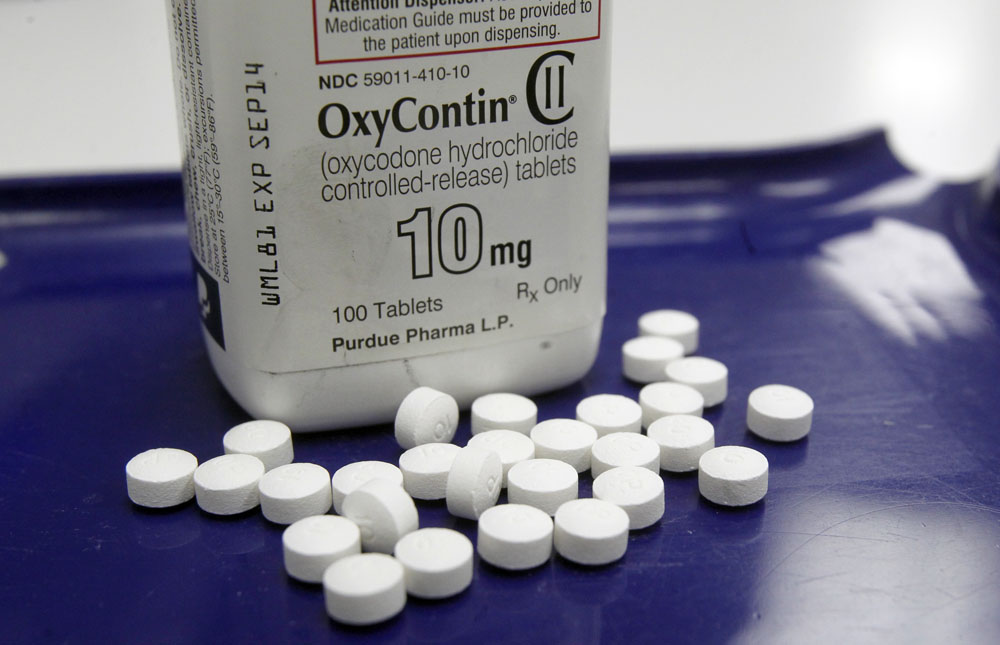President Obama stood before a crowd in West Virginia, a state ravaged by abuse of heavy painkillers, to roll out new provisions on how to combat the growing epidemic back in October.
“The numbers are big, but behind those numbers are incredible pain for families,” the president said after noting that in 2013, pain meds killed more than 16,000 Americans.
Chief among the problems is rampant overprescribing of painkillers. Federal figures show the number of painkiller prescriptions has nearly quadrupled since 1999.
“In 2012, 259 million prescriptions were written for these drugs, which is more than enough to give every American adult their own bottle of pills,” Obama said. “Some folks are prescribed these medications for good reason, but they become addicted because they’re so powerful.”

Kristen Rutledge discusses her battles with OxyContin addiction in Gilbert, W.Va. Abuse of the powerful prescription painkiller has exploded in the region. (AP Photo)
Despite the president’s rhetoric on the severity of the overprescribing, his administration has indefinitely delayed publication of new recommendations intended to curb the problem. The delay appears to be part of a larger showdown brewing between the administration and high-powered pharma-backed groups on the best way to deal with overdoses.
In September, the Centers for Disease Control and Prevention sent draft guidelines to certain medical groups that laid out instructions on how doctors should dole out painkillers.
The guideline is just that: a guideline. It doesn’t have any binding impact on how doctors practice medicine. The intention was to limit prescriptions to more severe cases.
Some suggestions include drug testing of patients before prescribing opioids for chronic pain, and annual testing for illicit drugs.
But advocates and lawmakers were hopeful word from one of the most prominent health agencies in the country would help alleviate too much prescribing.
The agency wanted to move quickly, getting the guidelines published by the first week in January. However, a potential legal fight, objections from a plethora of medical groups and even criticism from other federal agencies forced the CDC to hit the pause button on the guidelines.
Drug Overdose Deaths: HealthGrove
Now after a month-long comment period that ended on Jan. 13, the agency hasn’t set a date on when the guidelines will be out, ticking off public health experts and lawmakers.
“The clock is ticking and people are dying,” said G. Caleb Alexander, co-director of Johns Hopkins Center for Drug Safety and Effectiveness. “Any delay in these guidelines will increase the number of people who are dying or otherwise suffering injuries or deaths from these products.”
The CDC says 44 Americans die every day from opioid overdoses. The number of prescription opioid deaths from 2013 to 2014 went up 16 percent.
In light of the staggering toll of opioid abuse, the CDC’s delay is frustrating, said Sen. Joe Manchin, D-W.Va., an advocate for new measures to combat the problem.
“The CDC’s draft guidelines represent a reasonable, common-sense approach to help doctors take into account the very real and prevalent danger of addiction and overdose death when prescribing opioids,” he wrote in a letter to Department of Health and Human Services Secretary Sylvia Burwell last month.
Major opposition
Opponents say a major problem was the CDC didn’t adhere to federal law when it drafted the guidelines.
The guidelines were not posted in the Federal Register for review, and were not drafted by an advisory committee, various groups said. Other groups representing patients or healthcare professionals questioned the quality of the evidence that comprised the guidelines’ recommendations.
The pro-business Washington Legal Foundation openly questioned the legality, asserting that the guidelines weren’t drafted properly. The foundation sent a legal petition to the CDC in November, but didn’t implicitly threaten to sue.
“We don’t threaten lawsuits unless we are going to sue,” said Richard Samp, foundation chief counsel. “They exposed themselves to legal action by doing what they are doing.”
The foundation’s petition claimed the agency violated the Federal Advisory Committee Act. The law governs how federal agencies must use advisory committees that offer advice or draft regulations.
Advisory committees must meet openly and must publicly identify their members. The CDC didn’t do that when it formed an expert group to review the guidelines, the foundation said.
“It seemed as though CDC was interested in getting guidelines drafted very quickly and they operated basically in secret,” Samp said.
The CDC told the foundation the group wasn’t an advisory committee and that it provided individual consultation only. The legal petition disagreed, noting that even just getting advice from the panel is enough to label it an advisory committee.
Chief among the foundation’s concerns was the presence of two members of the advocacy group Physicians for Responsible Opioid Prescribing, or PROP, which has called for reigning in opioid prescriptions.
The group’s president and vice president, Jane Ballantyne and Gary Franklin, were part of the expert panel.
Ballantyne was a target of the legal foundation and other groups opposing the guidelines because she was a paid consultant for a law firm Cohen Milstein. The firm is now suing opioid manufacturer Purdue Pharma on behalf of Chicago, alleging the maker of oxycontin of improper marketing practices.
“Clearly those law firms have a vested interest in essentially saying that opioids have been too freely available and we need to cut back on that,” Samp said. “Jane Ballantyne was a paid consultant for this law firm that is going around the country shopping lawsuits. Clearly she has a financial interest in one result.”
Samp said the CDC chose the group “to confirm a bias in a particular direction rather than being fair and balanced.”
Most Abused Prescription Drugs in the United States: HealthGrove
Ballantyne responded that she provided only expert testimony because of her clinical and research experience, and she listed her work as a possible “conflict of interest.”
“It is up to whoever reads that declaration to decide to what degree my receiving fair pay to provide a report on the scientific evidence supporting chronic opioid therapy might have biased my opinion about the role of opioids in chroic pain,” she told the Washington Examiner.
Ballantyne added that if the opinion that the guideline is flawed “overwhelms support for the guideline, then it is reasonable to delay its release, take steps to verify that final document and the process by which it is drawn up is fair and balanced and proceed from there. That is exactly what the CDC is doing.”
Andrew Kolodny, PROP’s executive director, said they did not improperly influence the CDC and are experts in opioid addiction policies and science.
Ballantyne and Franklin are professors at the University of Washington. Franklin told the Examiner that PROP “had nothing to do with this. It is total hogwash.”
The experts’ involvement mainly centered on giving feedback on the guidelines that were already created by CDC staff, with Franklin adding that he “didn’t write one word.”
“The people who are criticizing what the CDC has done haven’t come up with one good idea to reverse the epidemic,” Franklin added.
Kolodny told the Examiner that the focus on the two PROP members is part of an effort by pharma-backed groups to “discredit the guideline.”
The foundation’s petition wasn’t the only opposition to the guidelines, which even received pushback from other federal agencies.
A National Institutes of Health pain research committee was concerned that the expert group lacked “people who suffer from pain or their advocates,” according to minutes from a December meeting.
The panel also described a low quality of evidence to drive the stringent recommendations in the guidelines. This brought up another question of whether the “weak evidence made the determination of the strength of the recommendation overly dependent on the make-up of the panel,” the minutes said.

“The numbers are big, but behind those numbers are incredible pain for families,” said President Obama in October to a crowd in West Virginia. (AP Photo)
The House Oversight Committee wrote to the CDC in December pushing for answers on the composition of the expert group and how the guideline was drafted.
Several advocacy groups also came out in opposition, most notably the American Cancer Society. The CDC developed the guidelines improperly and they weren’t based on solid evidence, the society’s advocacy arm said back in October.
“Guidelines sanctioned by the CDC are likely to be followed by doctors nationwide, and despite the lack of evidence here, there is the very real potential to erect barriers to pain medication that cancer patients and survivors need to cope with the symptoms of their disease and side effects of treatment,” said Chris Hansen, president of the society’s Cancer Action Network, in a statement.
The American Medical Association, the biggest doctor group in the country, also questioned the composition of the expert panel and the lack of time to comment on the guidelines.
“It appears that only a limited number of clinicians who are actively managing chronic pain patients were included,” the organization wrote to the CDC back in October.
The California Medical Association also slammed the guidelines, saying that the only time the public could view them was momentarily during an agency webinar. The agency then gave only about a day for groups to make comments.
‘A powerful industry’
Alexander, with the Johns Hopkins Center for Drug Safety and Effectiveness, said the idea that the guidelines would prevent patients from getting needed opioids is a “false dilemma.”
The argument “presupposes there are only two options — reduction of prescription opioid use or maintaining patients’ access to beneficial treatments. There are multiple options for doing both,” according to comments on the guidelines from Johns Hopkins Bloomberg School of Public Health.
Johns Hopkins also pushed back against the notion that the evidence based on the recommendations was low quality.

In September, the CDC sent draft guidelines to certain medical groups that laid out instructions on how doctors should dole out painkillers. (AP Photo)
“The topics that these guidelines address are never going to be subject to multiple large, multicenter randomized trials, and even if they were, there would be such bias in those trials based on recruitment that it would be difficult to apply to a large population,” the comments said.
Public health experts also questioned the influence of the pharmaceutical industry through pharma-backed groups in pushing for the delay.
“I think one important thing to look at is that you have a powerful industry that has made a lot of money on these medications,” said Colleen Barry, professor with Johns Hopkins Bloomberg School of Public Health. “Not all of the groups, but some of them, who have been raising concerns on access to pain medication are taking quite a bit of money from the industry.”
Alexander said there is a lot at stake for opioid manufacturers if prescriptions are lessened. “You had better believe they have a dog in this fight and will do everything they can to maintain the status quo,” he said.
Kolodny also questioned the motivations of certain outside groups, including the advocacy group called the American Academy of Pain Management.
The organization “claims to advocate for pain patients, but it’s the interests of opioid makers that it’s lobbying for,” he said. “A legitimate pain patient organization would not oppose more cautious prescribing of opioids.”
The academy denied the claim that it is influenced by pharma, saying that contributions from industry account for only 10 percent of its budget.
“That is not a motivating factor for us,” said Bob Twillman, executive director. “We want our members, who treat people with pain, to be able to do what we need to do to get the best possible treatment.”
Samp said the Washington Legal Foundation does not disclose its donors. Yet Purdue Pharma confirmed to the Examiner that it is a long-standing supporter of the foundation and has provided them with unrestricted grants.

In light of the staggering toll of opioid abuse, the CDC’s delay is frustrating, said Sen. Joe Manchin, D-W.Va., an advocate for new measures to combat the problem. (AP Photo)
What now?
The CDC told the Examiner that it created the 30-day comment period to be “responsive to feedback from our partners,” spokeswoman Courtney Lenard said. That includes the concerns raised by the legal foundation and others.
More than 3,000 people have offered comments, which the agency must now sift through.
On Jan. 7, it asked the National Center for Injury Prevention and Control’s Board of Scientific Counselors, a federal advisory committee, to review the guideline.
“We do not have a publication date at this time,” Lenard said. “The guideline is a priority for our agency. Given the lives lost and impacted every day, we have an acute sense of urgency to issue guidance quickly.”
The White House has pushed other initiatives to lessen opioid prescribing, including ensuring that federal departments provide training on prescribing opioids to federal healthcare professionals.
Policy makers have also focused on expanding access to treatments for combating prescription drug and heroin overdoses and addiction.
More than 40 provider groups have also recently announced a goal to train more than 540,000 healthcare providers over the next two years.
Alexander said he doesn’t think the delay will lead to further inaction on the opioid epidemic from Washington. However, he is still disturbed about the circumstances surrounding the delay.
“These types of recommendations from an agency such as the CDC are urgently needed,” he said. “Now it appears I think it is anybody’s guess whether they will be released.”

